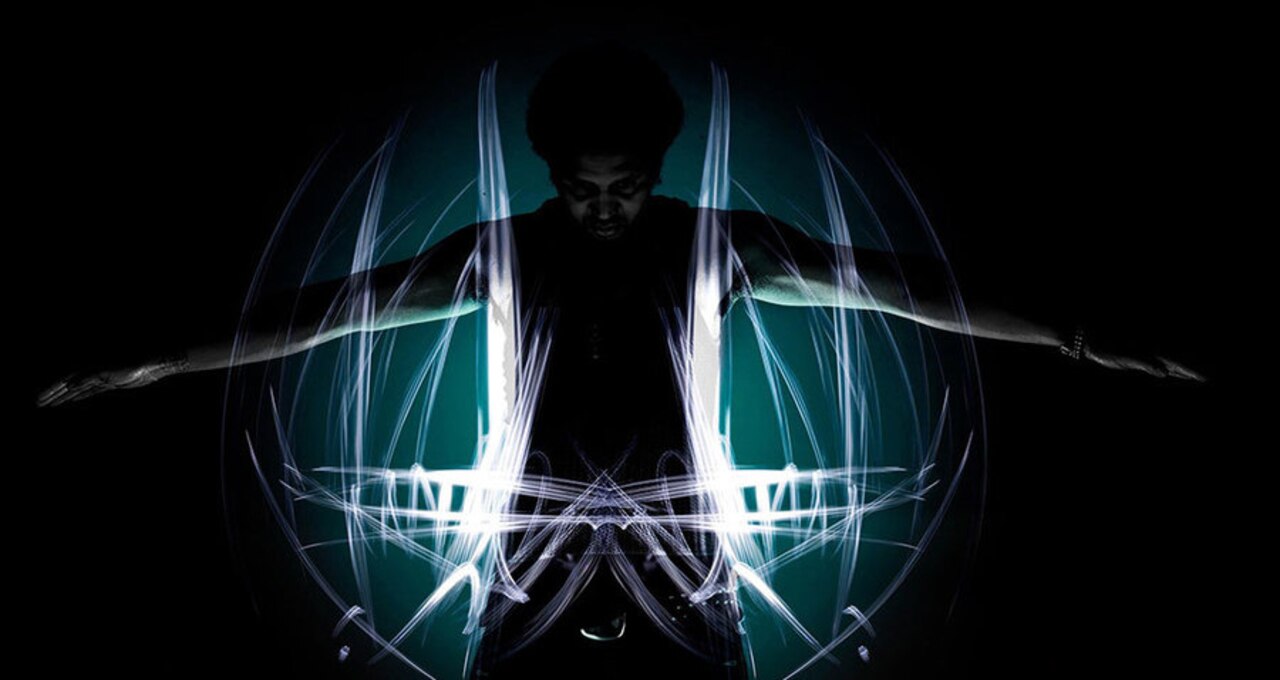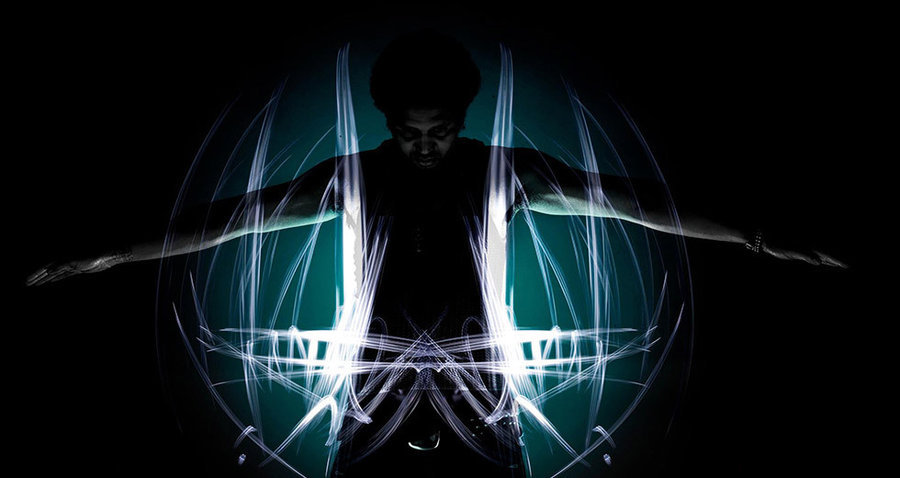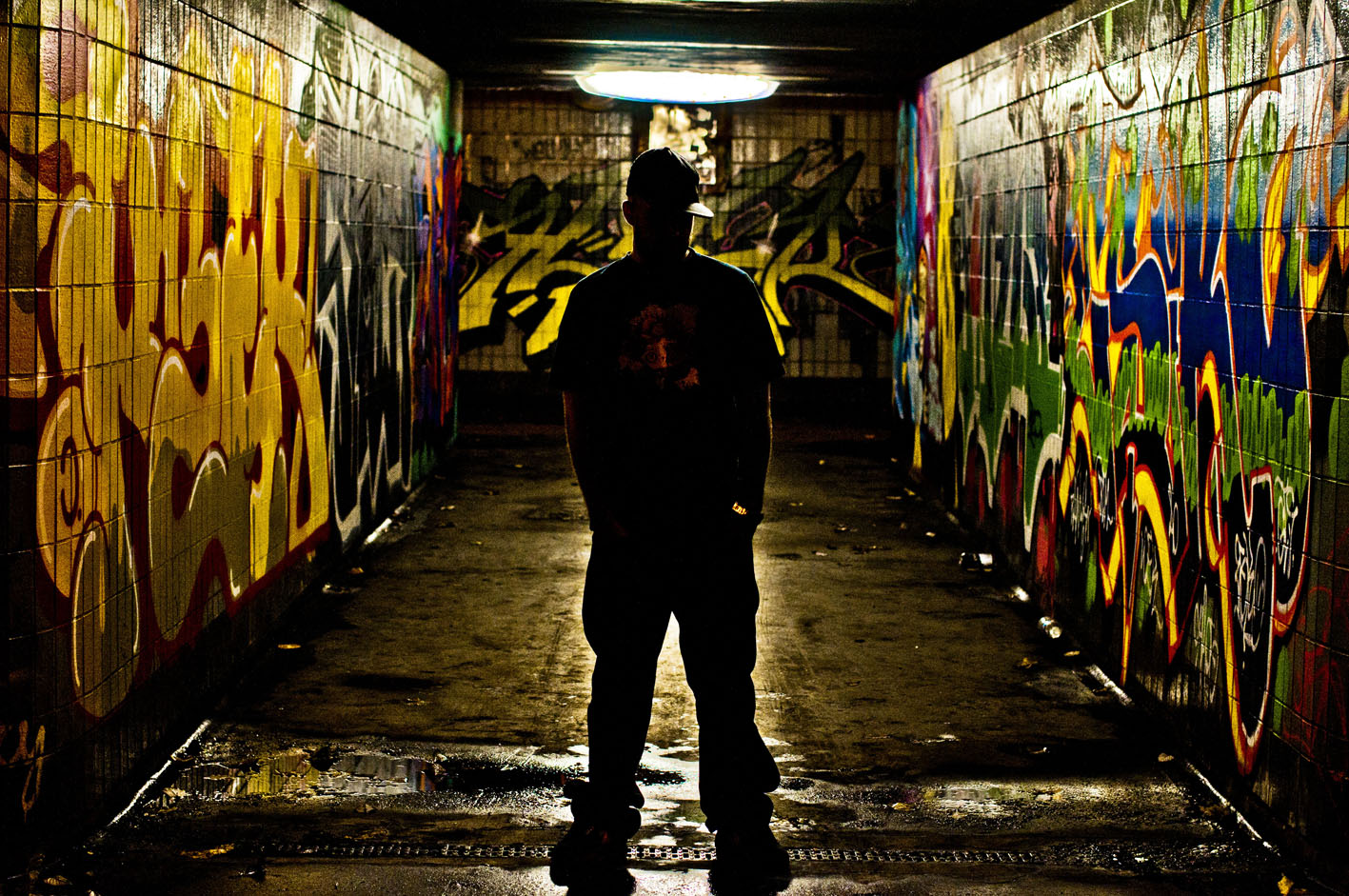Interview: Bristol’s DJ Krust
The drum & bass pioneer charts the connection between drum & bass and hip hop.

London and Bristol have a special relationship in the history of British sound system music. From the friendly rivalry between The Wild Bunch and Soul II Soul in the ’80s, to the cavernous tremors of dubstep 20 years later, the two cities have often experimented in tandem.
This relationship is perhaps best seen, and heard, in the quintessential ’90s British dance music genre: jungle. While the music’s roots lay in and near the capital, cities like Ipswich, Coventry and Bristol all played a hand in creating the scene and shaping the sound in its early days. As the music sped up and fluid breakbeats emerged from more rigid hardcore and techno roots, Bristol became the ying to London’s yang and, together, made jungle a worldwide phenomenon.
Amid the dubwise and heady sounds of Portishead, Massive Attack and Smith & Mighty, a small group of friends would go on to stake Bristol’s claim in the rise of jungle. Roni Size, DJ Die, Suv and Krust were local kids raised on a diet of hip hop and sound systems, and a chance meeting with London DJ Bryan Gee helped them create a Bristol-London connection that would become one of the strongest in the scene. In 1993 they set up a record label, and ended up releasing a series of genre-defining tracks throughout the rest of the decade.
Laurent Fintoni recently caught up with Krust – AKA Kirk Thompson – to talk about the birth of drum & bass in Bristol and much more.
Perhaps a good place to start is with hip hop, considering how influential that was for you.
Sure, of course. I got into hip hop at around 14 years old. The pivotal moment was Wild Style because up until then, we didn’t really see the culture. One day, my eldest brother brought this video home and told me to watch it, and our heads just exploded. We formed this little crew and talked about it all the time. I grew up in a council estate with about seven other black families in the area, so there wasn’t much outside that I could identify with. When I saw Wild Style, though, I saw all these kids that looked like me who’d done something within their community: breakdancing, scratching, it was like, “Fuck, that was what I wanted to do.” And I’ve been doing the same thing in various different styles since.
What was Bristol like in those early days?
When I started going clubbing in the 1980s, a spot called the Dugout was a popular. And there were warehouse parties, with people breaking and graffing. Graffiti wasn’t widespread yet and breakdancing was just part of Saturday afternoons, with linos on the street. Pirate radio was playing a little bit of hip hop, but we relied on cassette tapes a lot. A friend of ours was the cousin of someone in Wild Bunch, so we’d get their cassettes really early on. Also, a lot of WBLS tapes from New York. We were starting to hear hip hop from abroad, but prior to that there was nothing. Where I grew up, in northwest Bristol, there was nothing. They used to call us “Hilltop”: we lived so far away you had to walk up two hills to get to us, and no one came to our side of town. That was one of the impetus for us to start doing what we did.
At which point did you begin to draw parallels between Jamaican sound system music and hip hop?
We have a thing in Bristol called St Paul’s Carnival. There’d be sound systems, food – real displays of West Indian culture. From 15 onwards I remember watching Wild Bunch play on these ridiculous sound systems, with speakers 20 feet high. You’d go there and listen to the new music, see who’s wearing the fly clothes, hear some new lyrics and what new tracks were playing. That’s when we started to hear hip hop, electro and house all mixed together.
I remember from about 17 onwards that there was always a house party in St Paul’s or Montpellier. Guys like 2 Bad, FBI, Wild Bunch, or someone from those crews, would be DJing. Smith & Mighty used to do some parties, and then later on we started our own. The mixing style was totally different from that of today. When we first heard “Eric B For President” it was, and felt, so new. It was a brand new configuration of hip hop and beats. At one of the carnivals, Wild Bunch played that and “Rebel Without a Pause” almost back to back, and the crowd went bananas. It’s like hip hop had come to this next level. Comparing it to now is difficult, but when this music was played on vinyl it just killed it. It was warm and saturated; you could really feel and hear this new, totally different sound. It was nuts.
Fresh 4 was your first musical endeavour and you mentioned doing parties, so which came first?
It was the parties. Fresh 4 started while we were still at school. After we saw Wild Style, we asked the school if we could have a room to hold a school disco and they said, “Yes.” We borrowed a tape recorder, put lino down, charged people two pence to get in, and off we went. There’d be like, 20 people there. We then took it to a youth club and after that we moved to a squat. By then we were 17, 18, and that’s when we started inviting people from the other side of town. There were no parties in our area. After about six months it got bigger and more popular, so we made a name for ourselves as a crew who could do moves.
While all of this is going on, Flynn, my brother, has this idea of putting “Funky Drummer” with Faze O’s “Riding High,” and from there he goes on to work with Smith & Mighty in their studio for a year. That’s when he put together what became “Wishing On a Star,” which was the first Fresh 4 single. The track went Top 10 and we got signed to Virgin, so we ended up in London for nearly two years, working on an album. Fresh 4 being signed to a major didn’t work out, though. We got dropped after two years. We were young and naïve, but I knew I wanted to learn how to make music.
He got a computer, and that was it. I didn’t do anything for the next few years.
When I came back to Bristol I stayed in my brother’s house, and I lived in his back room on the floor because he had a sampler, a Casio FZ. I stayed in that room until I’d mastered that sampler, about eight months later. One day a friend of Smith & Mighty’s called Charlie Cheese called a meeting – because he got a copy of Cubase, ha. I remember it clear as day: eight of us round his, showing us how it worked. Before then I was using this little Alesis HR16 sequencer, which was a nightmare. Charlie talked us through Cubase and it was amazing to us. He burned us all a copy and I went back and showed my brother. He got a computer, and that was it. I didn’t do anything for the next few years.
Die, Suv and myself were all learning how to use equipment at the same time. Die was learning about music with Jody [Wisternoff], and together they formed Sub Love. Suv and I had been friends since we were eight years old. We were together in Fresh 4 with my older brother, Flynn. Suv and I had moved down to St Paul’s into a flat together and Die then moved into Smith & Mighty’s house, and we started hanging out. They lived around the corner and they had a back room with that FZ sampler and an Atari 1040, and all of us would go there, nearly every day, making beats. Rob [Smith] and Ray [Mighty] were really good to us, too. I’d watch them and learn about mixdowns, trying to understand what was going on. That played a big part in my development as an artist.
So you guys were in the mix, so to speak, of this Bristol ecosystem, that also had bands like Massive Attack and Portishead at the time?
Yes. We started making slow, experimental music, but we were also going to raves every weekend in the countryside. The southwest was pretty happening at the time. We felt rave music was the next thing. We’d listened to hip hop and house music, and then all of a sudden rave happened. We were about following the culture of experimental music and this was cutting edge, new, so that’s what we were into.
We came to really understand breaks... It became a science for us.
Going back to our studio, we’d start with a flat beat and then put a break on top. We did that for a while until one day we decided to take the flat beat out, which was the rave element; so we’re left with this breakbeat, rolling at 150 BPM, which we decided to keep going. Then we’d go digging in the crates – since we had these big collections from being scratch DJs – and when we recognised the breaks people were using we started to put the pieces together. We came to really understand breaks, and how to edit them in the right place (the sampler only held about 14 seconds, so we got super good at chopping and looping). It became a science for us.
What was your first dance music release?
The first thing we did was on our own imprint with Smith & Mighty, which isn’t very well known. It was Suv, Flynn and myself. They subbed us a label and we put out some experimental things. I don’t even remember the name of the label, but we were called Hocus Pocus. It was in the same ravey vibe of the times: 140 to 150 BPM, with lots of bass, flat beats and breaks weaved in together. We did two releases, but no one knew how to do the record thing properly. It just fizzled out.
But let me jump back for a minute. When we were doing the warehouse parties we used to hire a sound system, which is how we met Roni. His brother used to run the system and Roni would come in and engineer for it. Through all of this, Suv, Die and myself were sitting around talking about all these beats we had, and how we could get this stuff out. Suv had met Roni at a party a couple months’ before, and Roni had mentioned also wanting to put stuff out, so we decided to all sit down and talk about how to do it together. We had a meeting in my old flat, and that was the start of what became Full Cycle. After sending demos to a lot of places, and getting ridiculous replies, we decided to do our own label. It was like, “No one understands where we’re coming from, so let’s do it ourselves.”
Through Roni, one of our tapes ended up with Bryan Gee. That was the next penny dropping moment for me because as soon as Gee walked into the room, we knew. We were all dreads, and he was a dread. We sat down for hours, talking about music and what we were all going to do. He had a name for his label, V Recordings, and a concept. It was the next thing for us because they had the London thing on lock. Bryan was a big DJ in that experimental era: he was running with Jumpin Jack Frost and that’s when we started to hear more and more of this same music, which people began calling jungle. We knew then, “This is where we fit in.”
You’d mentioned before that you started trying to make hip hop, but then it sped up around the same time jungle became a thing. With the benefit of hindsight, what was that moment like?
I can only speak for myself, but I once we got past 150 BPM, I knew it was something else. I was happy in a space where I could push and pull. We’d listen to Shut Up And Dance, 4 Hero, We Are I.E. – and a lot of early techno stuff, too, like Moby’s “Go.” When tracks with breaks became more predominant it was exciting, because it became more accepted that this was a form that was working. People would start playing entire sets of it. There was a format: 160 BPM, and a flat beat or a break.
We realised we were part of the culture at that point. Prior to that we heard things from up north. I’d hear about a guy called Doc Scott. Or Ratty and Tango. Q Project up in Oxford. Mickey Finn and JJ Frost. Everything’s pointing to this one road. And then, we heard about this big rave: Jungle Fever at the Edge, in Coventry. The whole thing was there: the music, the culture, the talk, the dance, the MC styles. It had blossomed. It was colourful, beautiful. That was when we knew we’d landed.
I’ve always felt that the UK was different to other countries because you mutated hip hop culture. Looking back, it’s hard not to see jungle as an answer to the hip hop that had landed in the UK ten years before.
Definitely. There aren’t many cultures in the world that do what the British do with music, with ideas. We loved hip hop but as a b-boy you can’t bite, so trying to make American sounding hip hop would be the worst thing. When we began making jungle, I still felt like I was contributing to the culture. When we went to New York for the first time in 1999 we met people like Chuck D and Kenny Dope, and they liked our sound. People there knew that it was something different, something new, but that they could relate to it from a cultural angle. That’s what was amazing. We created this music and exported it around the world. We were being recognised in our own right as artists and creators.
For some American hip hop artists, jungle and drum & bass made sense in how it linked back to hip hop through beats and tempo.
I remember a lot of hip hop cats here back then didn’t get it. UK guys were like, “No, this isn’t hip hop.” After a while a few people started to come across and understand it. The producers were first. We used to do big Full Cycle parties at The End and we’d have non-jungle DJs play, like Kenny Dope and Gilles Peterson, which we did specifically to say that this was the root of where we’re coming from. Those guys would invite us to come play for them, too. We tried to bridge the two things.
Back in the day there was no house scene, no hip hop scene, no jungle scene. It was all just the Bristol scene. When we talked about jungle, we did it the same way people talked about jazz. When it was hip hop it was about the culture, so to be jungle was about bringing across a whole attitude of what the culture represents. We dressed differently and spoke differently from everyone in the scene. It’s not that we wanted to separate ourselves: we wanted you to come and have an experience.
Where do you think the push came from that took jungle past its UK roots?
It was a mix of things. I think that when the tempo hit 170 BPM, it became very addictive. Frequencies do things to people. It doesn’t matter where you are, what music is on before, if you put a jungle tune on, the party changes, the energy level changes. It was just so different: there were pockets of people around the world listening to cassettes, early internet radio stations, reading magazines. It sparked people’s imaginations. If it came from London or Britain, it carried a lot of weight. There aren’t many scenes outside of Britain and America that started modern music movements. When you think about the electronic expression of what the youth were doing back then, it was very different, exciting and creative – and typical of what Britain was doing. Taking music in, sampling it and giving it back to the world. I’ve had guys come up to me and say their dads used to play “Warhead” to them when they were five or six years old. That’s deep.
You also have to remember we were going through a change of governments in England. There was a lot of anger, energy and protest, and rave and jungle struck a chord with disenfranchised people. Half of the big raves going on around the world today are modelled after ideas that started here. It’s not that the British started it, but rave captured youth culture’s imagination. It was a combination of a lot of factors: young people finding themselves, their voice, and their place in society. This music created industries, too. It gave people who weren’t necessarily educated an opportunity to contribute to a society. There were magazines, radio, merchandise, PR… it created livelihoods. It was about how to be included in society and contribute to it, and I think that point can’t be left out of any discussion about the origins of the music.

